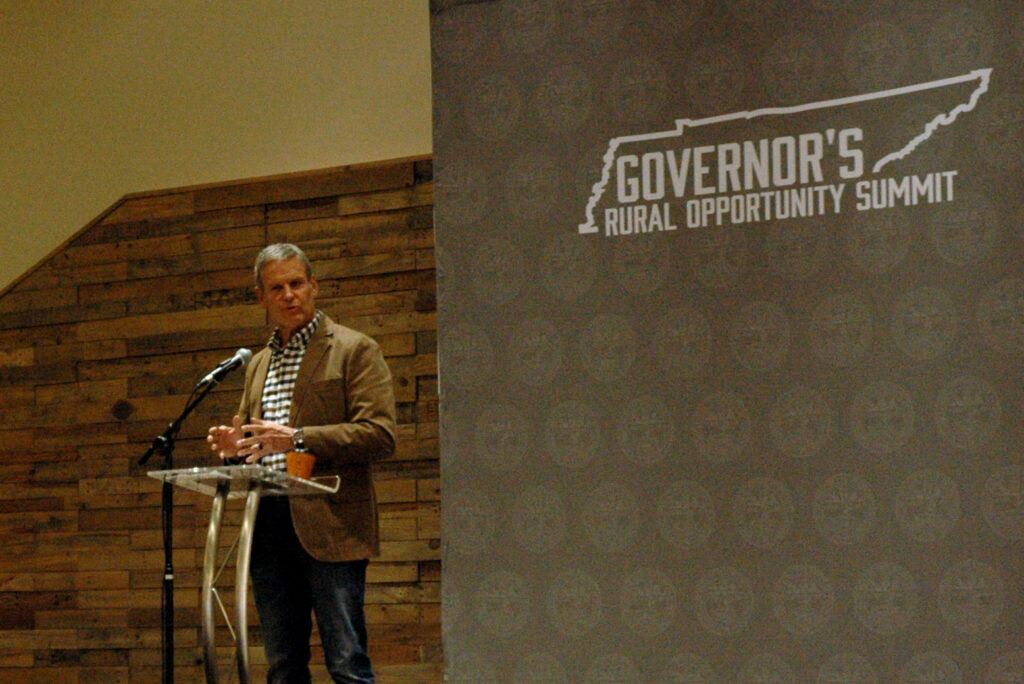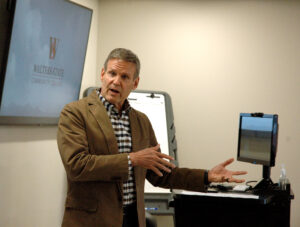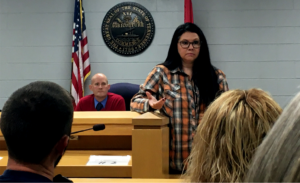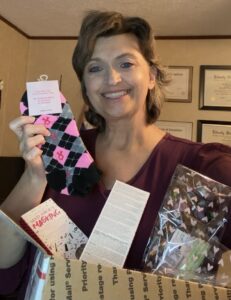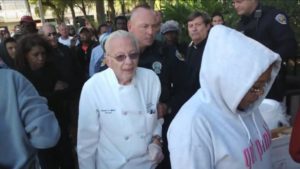
NEWPORT, Tenn.—For more than 120 years, the Conagra food processing factory in Newport had been in steady operation, servicing the nation’s food supply, empowering the local economy and providing a stable source of income for generations throughout eastern Tennessee.
Activity tapered over recent years, as executives from Conagra Brands moved production around the country, piece by piece, until the operation officially ended on the morning of October 22. Exactly one week prior, Conagra sold all of its Newport properties to the commercial real estate firm Phoenix Investors, for $8.16 million, according to state data. In its final week of production, the plant acquisition changed the running question from ‘who will buy the factory,’ to ‘who will rent it?’
Now, as Conagra slowly exits the facilities, Cocke County and Phoenix Investors are working together to find the right tenant, or multiple tenants, for the plant, warehouse and associated properties.
Agents from the Milwaukee, Wisconsin-based real estate firm bring their own lists of industrial contacts to be included alongside those of Lucas Graham, Economic Development Director and Cocke County Partnership President, who says that a larger company with marketing resources, industrial contacts, and a national outreach gives him greater hope for 2022.
“With the number of prospects that have already inquired about it, and are continuing to look at it, and look at it now, I have very high confidence that we’ll be able to fill the building,” Graham said. “It’s not a matter of if, it’s just when, at this point, and some of that is just depending on when Conagra is out of there.”
Graham said that although another potential company wants to tour the facilities by mid-January, because of COVID and logistical delays, Conagra has been slow to exit the warehouse, raising even more uncertainty about the immediate future of the plant.
However, the questions do not end there. For more than 300 former Conagra employees who have been laid off, the question of their futures go unanswered as insurance runs out, bills add up and severance packages begin to dwindle.
Furthermore, legally binding nondisclosure agreements have silenced former managers and supervisors in exchange for their own severance packages, preventing them from talking about their work. Ambiguous clauses in severance paperwork have made even the hourly employees hesitant to publicly discuss their own experiences at the plant, the nature of the shutdown or the impact of the Conagra withdrawal from Newport.
After contacting more than 20 former Conagra workers, only four would tell their stories to The Newport Plain Talk, and just one was willing to go on the record using her name.
Kim Brown, a Cosby native living in Dandridge, worked at the plant for 15 years until its closure in October. For the first 12 1/2 years she ran a palletizer on the bottle line, until the initial stages of the coming closure, when those operations were moved out of Newport, at which point she moved to the labeling department for the remainder of her career with the company.
“Conagra was a place, when you started working there, you retired from there,” she said. “You stayed there. That was my plan. 15 years of my life down the drain,” she said, sitting at a table in the back of Milano’s Pizza on Broadway, after a gathering of former Conagra workers. “There were people there who had 40 and 50 years seniority.”
Now, as she applies for other work, Brown is still processing the loss.
“It’s hard to explain what 12-hour days, five and six days a week, will do to you, when it feels like it’s never-ending and then all of a sudden it comes to a dead stop,” she said, “because we worked 12-hour days until the end, until that was it – until they were done – and it was rough.”
She said some people were working seven days a week, 12 hours a day, up until the factory shut down.
“I feel like nobody really knew what went on in there except for those of us that were living it,” she said. “It wasn’t a secret. It just wasn’t a well-known secret. The way we worked and the way we were treated.”
She compared loss of the plant to the death of a family member, and being in an abusive relationship.
“That’s exactly what it’s like. Everybody on the outside thinks they’re a great person, but you know that they’re not, and you can’t get away from it, and then every time you try to get away from it, they pull you back in,” she said. “Then, when you finally think you can get out, they get the news that they’re dying, and if you leave now, you’re a bad person. So do you stay or do you ride it out?”
Brown rested on the table with her elbows. She looked down at her hands, folded together.
“Those of us that rode it out are just glad it’s over with, honestly, because from the day that they announced we were losing the plant, morale just bottomed out. It was awful. We didn’t get treated differently by our own, but you could tell upper management – I’m talking like, corporate level – it was the total opposite, like we didn’t matter anymore. That was heartbreaking, because we showed up every single day for them, even after they fired us. It was like being fired and then still expected to show every day.”
Brown said the looming sense of abandonment was exacerbated by a lack of material support from above, forcing workers to make do without proper implements.
“We could tell the difference in like—it was hard for us to even get parts for the machinery to fix it when we needed it,” she said. “We had a lot of catastrophic breakdowns because we didn’t have the parts, because we were fixing to close the doors.”
Even then, she said, the Newport Conagra plant was outperforming all others in production.
“Even on our worst days, we would run circles around the other plants with our numbers. They couldn’t beat us. They couldn’t touch us, and we still got closed down. It doesn’t make any sense,” she said, “and I think that was the hardest part about it, because we knew that we were good people, regardless of what they felt, or how they saw us.”
Brown said she thinks people are afraid to talk about their feelings or opinions because of possible repercussions.
“Not that there would or could be any, because once they terminated us, that was it,” she said. “This is nothing I haven’t said to everybody else. I’m not sugarcoating anything, and I’m not making anything up. It’s just the harsh reality.”
Another former Conagra worker, a Newport woman who spent 13 years at the company and asked not to be named for legal reasons, said she felt the company was attempting to buy her silence, and does not believe people understood the terms of the severance papers as they signed them.
“You’re going to see on there, basically that we can not sue them, and that if anything negative comes up that we have to stand up for them,” she said. “I don’t know if other companies do that or not.”
She said her insurance benefits expired a week after being laid off, and now she and her two children have no medical coverage. She said when she went to the American Job Center in Morristown, seeking unemployment benefits, she was transferred to Sevierville because at that time, Morristown was inundated with new applicants.
“They said they’ve had a couple of plant closings, and so the lady who I talked to in Morristown transferred me to the one in Sevierville, because they had more people, I guess.”
Now, to stretch her savings, she works part time at a grocery store.
Between what she currently has in the credit union, and her severance pay of about $10,000, she said she has enough money to survive for one year. However, because she is enrolled in a 20-month computer certification course at the Tennessee College of Applied Technology, she will have to cash out her 401(k) to make ends meet during that time, before she completely runs out of money between careers.
Her husband, who retired from Conagra after 40 years, but before the plant closure, said he was not treated well at the company, adding that Quaker – the previous corporation to own the plant – treated workers with dignity.
“They could have done better than what they did,” he said over the phone. “Conagra don’t care about its employees like Quaker and Stokely did. Quaker would give you awards for good work you done, and Stokely’s would congratulate you and everything, but Conagra never would give nothing to nobody.”
In a parked car by the edge of Cosby Highway, she clutched a blue Gateway laptop computer to her chest as she spoke – a Christmas gift from her daughter for school. She said she does not want to have to cash out her 401(k) but there is no other way to survive.
“My expenses each month are around $2,000 a month. Right now, I can not get it down any further. I don’t have cable. I don’t have satellite. I don’t have internet except through Verizon Wi-Fi, and I have a data plan with a hot spot on my phone,” she said, her voice getting smaller and beginning to stammer. “It ain’t good. I mean, I would love to know what Conagra was like, thinking, but I mean it just is—they ain’t going to tell you anything.”
Another former Conagra worker, a male who cased product at the plant over four years, asked not to be named for personal reasons, and now works under the table for a neighbor. He said he lost his insurance and is now facing thousands in medical bills.
“I had to go to the doctor on Friday,” he said. “It cost me $600 for four x-rays and two shots, plus my medicine at the pharmacy.”
Brown confirmed via text that signing up for insurance following the closure had become a convoluted process, marred by inefficiency as well as Conagra coming up short on promised payments to help cover the cost of a private insurer.
“They told us they were gonna give us money to cover for 3 months of extra coverage,” she stated via text, “then at the end they only gave us half of what they said they would. Some of us were about to get insurance because of the company laying us off, but the guy signing people up was so swamped that he couldn’t get to everybody so more people than not were left without coverage. And the premiums for coverage skyrocket on Jan 1st, so it’s either find a job with insurance or go without.”
The male Conagra worker said during his time at the plant, 12-hour days were normal, and it was not unusual to work 16-hour days, up to 96 hours per week.
“If you went in early four hours on another job, and they was overtime on your job, you was forced to take that, so that forced you to work 16 hours a day,” he said. “It’s a shame that they shut the plant down, you know? They said that plant was the number one producing plant for the whole Conagra, outrunning every other plant that Conagra had.
“When you work 12 hours a day, you get to know the equipment and how to run it, and they can put the product out. They said the other plants are only running like 300 to 400 cans a minute, and that one was running 900 to a thousand. I mean, it was putting it out, it was. Sometimes labeling couldn’t keep up with us because we were running too fast.”
Like others in his position, he is still adjusting to the gap in his daily schedule.
Brown said she, too, is adjusting to the collapse of her routine.
“I still wake up in the middle of the night,” she said. “I was having to get up at 1:30 in the morning, be at work by 3, and work 3 to 3, and then come home, try to get whatever I needed done, and be in bed at a decent time, and it never happened.”
Leading up to the closure, there were extensions put in place by the company to meet increased demand as a response to COVID.
“I told the plant manager, and I told the HR manager – because we were already on overtime at that time – I told them if y’all are going to throw money at me, I’m going to take it. I did not know it was going to be extended three more times,” she said.
She said people on the outside who only knew how much Conagra workers were often paid, failed to see what employees sacrificed in order to remain there.
“You tell people you work at Conagra, and the first thing they say is, ‘Oh, you make all kinds of money,’ and it’s like: I bet you enjoy your holidays and weekends off, don’t you? You get to enjoy birthdays. You get to enjoy graduations, and get-togethers, and all the holidays. We have to give that up. That’s what we’re there for. We’re there to make money,” she said. “People that don’t work—” she stopped to correct herself, “that didn’t work there, didn’t see how much we had to give up to get that. And now it’s like, ‘Oh, we don’t need you anymore.’ What do you say to that? It’s awful.”
She said jobs at the Conagra plant were sought after, because people knew they could make money at it, and that a person could even retire from the company, but she said most people do not understand how far their sacrifices went.
“I had a terrible quality of life. I mean yeah, I got my bills paid and everything. That’s—that’s great,” she said. “But all the stuff that I’ve missed over the years: I missed my niece being born. I missed, I don’t know how many, graduations. I don’t know how many holidays. Family functions. All that stuff. I remember one time I took the day off – I actually had to take the day off – to go to my nephew’s birthday party, and I saw a picture of me later, and I looked just exhausted. I had worked until 3 o’clock that morning, and then I had plans that day to go somewhere, for something, and then go back to the birthday party, and the look on my face, I just—I was just exhausted. I thought to myself, ‘I don’t have to do that now.’”
Brown said the photo was taken almost 10 years ago, emphasizing that she worked mandatory overtime for the entire 15 years she worked for Conagra, and that everyone was subjected to the same expectations of a poor work-life balance.
“That’s what we have all had to deal with,” she said. “It’s not just been one person or another, or one job or one department, or anything like that. It’s the entire plant.”
As the closure became more imminent, and more workers retired, Brown said demands climaxed upon the remaining workers, holding out for their severance pay.
“Gosh, I’m telling you what,” she said, placing the palms of her hands against her forehead, and rubbing her face. “It completely changed the way it felt. I can handle overtime, but to be fired, but still expect to show up every day for 12-hour shifts, and do the job of two and four people because we were so short-handed, it was insane.”
She said the day when it was announced the plant would no longer be producing bottles, was the same day Conagra Brands acquired Pinnacle Foods, in June 2018. However, they would only hear about the acquisition by word of mouth, which she and some of the other workers believe indicates that the company was already making moves toward a total closure, well in advance of when executives chose to tell the workers. A man in a suit, accompanied by guards, had come to inform them.
“The guy that came to close us down hated Newport with a passion,” she said. “He came in to deliver the news both times, with armed guards, because other places he had closed down like, threw chairs at him and stuff. He came to us with armed guards, and we were all like, ‘What are we supposed to do with this?’ You know?”
She said before he showed up, they had already heard rumors about him.
“Sure enough, he showed up with armed guards. Actually left out the back door,” she said. “He was just there to shut us down, because his pick was a plant in Ohio.”
Brown said his name is Bill Gates. Not to be confused with the co-founder of Microsoft, the Bill Gates of Conagra Brands has been with the company for more than 20 years and is listed on LinkedIn as the Vice President of Manufacturing at Conagra.
“I’m pretty sure that’s his name,” Brown said. “I’ve had to use the words, ‘Not that Bill Gates.’”
Even without guards, Brown said a man in a suit looked out of place at her 120-year-old factory. She said his guards wore suits, and although no guns were displayed, she said they had a way about them that seemed to indicate they were armed.
“They drew attention to the situation,” she said. “They didn’t draw attention to themselves.”
Brown said between the workers and management, she and her colleagues were not treated badly, but she did not like how the corporation treated the workers of Newport. Still, Brown said she would like for people to not focus on Conagra closing.
“There’s other things out there, than just Conagra. The end of Conagra is not the end of this area,” she said. “It’s really not.”
She said she does not consider herself to be in competition with the 300 people who lost their jobs in the plant closure. She said that number is closer to 200, because so many either retired or are waiting longer to find something.
“As big of an employer as it was – at one time we had almost 500 people before we lost bottles – 500 people is not that many people when you sit down and you look at the numbers of this county,” she said. “But look at how many people—there’s a ripple effect, OK? You’ve got the utilities that, I’ve heard for years, that Conagra was 60% of the Newport Utilities. It was a huge number, but look at everything else around it: Land taxes. You’ve got the businesses like Brock’s and Jabo’s. You know, people would eat there every day. The fast food places around town, people would eat at every day. You’ve got the families of the people that work there.”
Brown said that although she moved to Dandridge years ago, she still conducted much of her business in Cocke County.
“Grocery shopping, whether it was Food City, or Walmart, or what-have-you. I’ve still got a post office box here. You know, if I’m buying gas or whatever, you know, it’s a big impact, and when you start taking that away, and things start rolling downhill and dwindling down, you finally see it may have been 500 people, but it affected everything,” she said.
“I feel like just because it’s effecting everything doesn’t mean you have to let things die with it. Branch out. There’s plenty of places hiring. It may not be what any of us want right now, and that’s OK. Doesn’t mean you can’t try something else.”
She said she has heard of her former coworkers getting new jobs at the Ball plant, Eternal Beverages and Ole Smoky Distillery. Brown said she has applied to a few places, including Ole Smoky, and hopes to hear something back soon.
“However you want to look at it, I’m not worried,” she said. “I’m really not, because if I don’t get hired there, I’ll go somewhere else.”
Workers said it was possible to follow Conagra, working at one of their other plants, but Brown said she would not consider offers to follow Conagra to another plant after the closure.
“I also didn’t hear of anybody talking about doing it. If it were me? No. You cut my throat once, why would I give you the chance to do it again?” she asked. “I’ve even went so far as to tell people don’t pick up the Hunt’s product, the store brand’s better, you might want to get something else. Honestly, I have. I’ve done that more than once.”
She smiled. Brown said she, her friends, and former colleagues, have always used Conagra products in their food, and still have some at home in their pantries, but after it runs out, they will not be purchasing more.
“We said once we’re done using it, we’re not buying it again. It sounds petty. It seems petty, but why would I support a company that just cut my throat?”
Graham said the number of prospects looking at the Conagra facility has grown to 12, several of which are seeking a partial lease, not needing the entire facility. While the majority are full scale operations, he said there are at least four companies showing an interest in smaller sections of the full plant, splitting the plant and warehouse, and other uses of the buildings to be leased by Phoenix Investors.
“Instead of having one big company that if they leave like Conagra did, it’s going to have this massive impact to the economy at one time, it busts up the risk,” he said. “So if one of those tenants were to have a bad year and go under, for example, then it would only be a portion—it would be less of a hit to the local economy than what we just experienced with Conagra leaving.
He said there is a high probability that in the next two years the county will surpass expectations of job losses or breaking even, and eventually see a net increase in jobs.
“We need to have some numbers and offers on the table, so I know what numbers I have to work with, so I’m not giving away the farm,” Graham said. “I don’t want to give away anymore tax dollars and incentives than I have to.”
Representatives from Conagra did not return email, or phone messages left at the office. Alan Jones, a representative for United Steelworkers, did not return numerous messages left on his cellphone. Representatives from Phoenix Investors did not return calls to their office.
This story appeared in The Newport Plain Talk.




